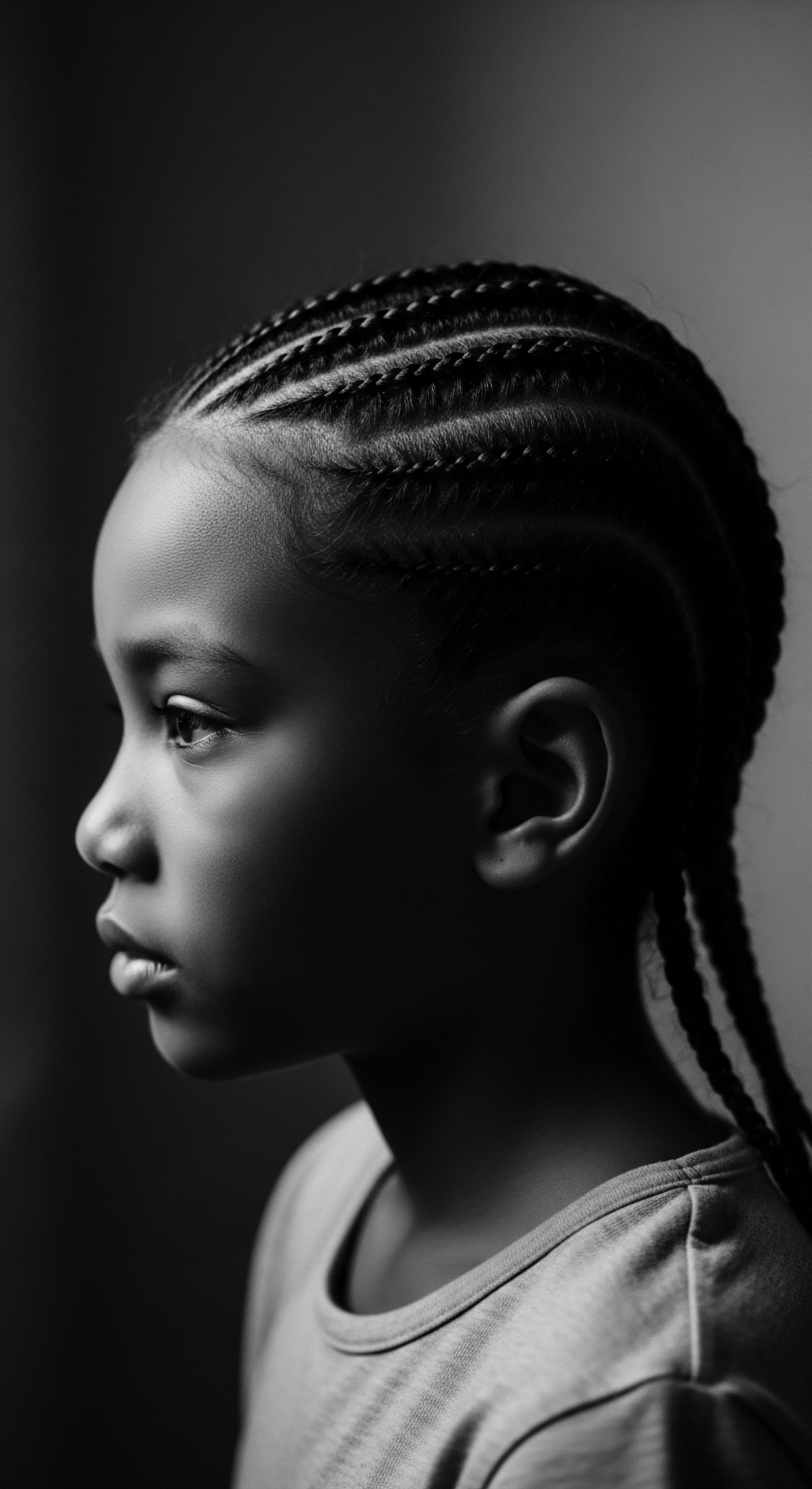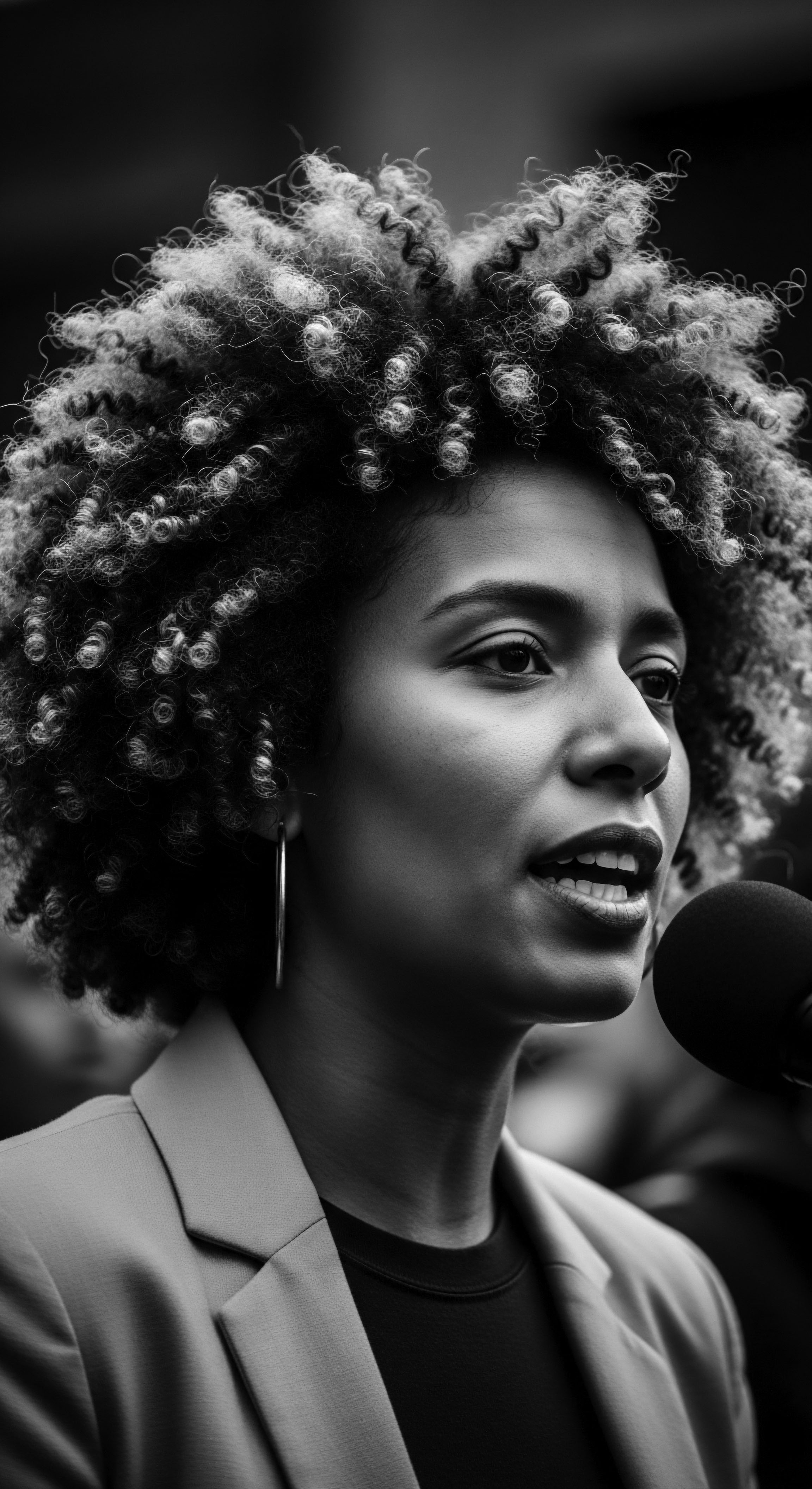
Roots
To those who have felt the intimate whisper of silk against carefully coiffed curls, or the reassuring embrace of a familiar fabric settling over freshly styled coils, the bonnet is more than a simple adornment. It stands as a profound testament, a living artifact cradling centuries of textured hair heritage and the deep resilience etched into the very fiber of Black and mixed-race experiences. This journey into the bonnet’s lasting meaning begins not with its practical utility—though that remains undeniable—but with its ancient echoes, a reverberation from ancestral lands where head coverings held spiritual weight and communal language.
Consider the intricate anatomy of textured hair, a marvel of biological design. Its unique helical structure, its varied curl patterns, and its inherent need for moisture protection were understood intuitively by forebears. Long before modern scientific instruments could map the precise protein bonds, indigenous wisdom recognized the delicate balance required for hair vitality.
Across diverse African cultures, head coverings, such as the Ghanaian Duku or the Namibian Doek, served not just as protection from the elements, but as powerful visual cues reflecting a person’s standing, their wealth, their marital status, or even their emotional state. This deep cultural grammar of hair adornment, where the covering spoke volumes, laid a foundation for what the bonnet would later become, a guardian of these delicate strands and a silent storyteller of survival.

Ancestral Threads Protecting Hair
The origins of head coverings for protecting hair reach back to the dawn of civilizations, predating the specific form of the bonnet we recognize today. In various African societies, coverings were integral to daily life, offering both practical defense against environmental aggressors like sun and dust, and symbolizing a host of social realities. These early practices were built upon an innate understanding of hair’s vulnerability, particularly textured hair, which by its nature is prone to dryness and breakage if not carefully shielded.
The careful wrapping of hair, whether for a journey, a communal gathering, or rest, speaks to an ancient, continuous thread of deliberate care. This ancestral wisdom, passed down through generations, shaped a heritage of protective measures that prioritized the well-being of hair, long before contemporary hair science confirmed the benefits of reducing friction and maintaining moisture.
The bonnet, in its quiet dignity, holds within its folds the deep wisdom of generations safeguarding textured hair.

Head Covering Nomenclature and Meaning
The lexicon surrounding head coverings within textured hair heritage spans continents and centuries. Each term carries a particular cultural resonance, a distinct lineage of meaning.
- Duku ❉ A term for headwraps originating in Ghana, symbolizing various social statuses and cultural expressions.
- Doek ❉ Used in Namibia, among other regions, this term refers to headwraps that conveyed identity markers.
- Tignon ❉ Specific to laws imposed in colonial Louisiana, requiring women of color to cover their hair, paradoxically leading to elaborate and defiant styling.
- Gele ❉ A prominent headwrap in West Africa, especially among the Yoruba, often tied in elaborate, sculptural forms for celebratory occasions.
These terms, though varied, share a common undercurrent ❉ the head covering as a medium for communication and a vessel of cultural continuity. The understanding of hair anatomy, from the tight coiling helix to its inherent porosity, implicitly informed these early practices. The materials chosen—often cotton, eventually silk or satin—were selected, perhaps intuitively, for their ability to protect the hair’s integrity, minimizing friction and preserving the hair’s natural moisture, a scientific truth echoed in ancestral care.
The historical journey of the bonnet is thus deeply rooted in the primal understanding of hair’s delicate composition and its sacred place within identity. From the very start, head coverings offered a shield, a silent guardian for the vitality and spirit of textured hair. This ancient practice, born of necessity and elevated by communal meaning, set the stage for the bonnet to become a profound emblem of resilience across time.

Ritual
The bonnet’s trajectory from a simple head covering to a potent symbol within textured hair heritage deepened considerably through the crucible of ritual. This transformation, profoundly shaped by historical adversity and the enduring spirit of Black communities, reveals how an item of practical utility became infused with layers of defiance, self-preservation, and identity. Its use became a daily affirmation, a deliberate act of care that transcended mere grooming to become a deeply personal and communal ritual.
During the horrific period of enslavement, head coverings, including rudimentary bonnets or kerchiefs, were often forced upon Black women. These coverings were intended by oppressors to strip away individuality, to mark enslaved people as subordinate, and to obscure the rich, diverse hair traditions that connected individuals to their African ancestry. Yet, in a powerful inversion, Black women transformed these very mandates into vehicles of resistance. They utilized the folds of their head coverings for covert communication, devising intricate ties and styles that signaled messages unbeknownst to their enslavers.
(Donaldson, 2022). This act alone – turning a tool of subjugation into a means of silent rebellion – solidified the bonnet’s place as a symbol of profound human spirit.

The Bonnet as a Shield and Statement
After the abolition of slavery, the bonnet, despite its lingering association with servitude in dominant society, continued to hold immense significance for Black women. It was maintained, adapted, and celebrated, precisely because it offered tangible benefits for hair care that resonated with ancestral practices. The material choice of silk or satin became paramount, recognized for its ability to reduce friction and preserve moisture, qualities crucial for the unique needs of textured hair. This understanding, passed through oral tradition and lived experience, predated scientific explanations of cuticle smoothing and moisture retention.
The bonnet became a cornerstone of the nightly ritual, a quiet moment of self-care and preservation. It safeguarded intricate braided styles, twists, and coils, extending their longevity and minimizing the breakage that prolonged exposure to harsher fabrics could cause. This routine was not simply about appearance; it was about protecting a sacred aspect of self, a legacy of beauty, and an inherited connection to ancestral care philosophies.
Beyond its utility, the bonnet became a canvas for silent defiance and a keeper of ancestral knowledge, protecting hair while preserving spirit.

Nighttime Sanctuary and Communal Ties
The nighttime donning of a bonnet or headwrap evolved into a sacred moment, a quiet reaffirmation of self away from the gaze of a world that often devalued Black beauty. This daily ritual connected women to a collective experience, a shared understanding of nurturing and preserving one’s crown. The practice reinforced communal bonds, as mothers taught daughters the proper techniques for wrapping and caring for their hair. This intimate knowledge transfer, steeped in practical wisdom and cultural pride, became a cornerstone of textured hair heritage .
| Historical Purpose Protection against elements and labor conditions ❉ Shielding hair from dust, sun, and grime during arduous tasks. |
| Contemporary Continuation Hair preservation and style longevity ❉ Protecting styles like braids, twists, and silk presses from friction and frizz overnight. |
| Historical Purpose Coded communication and resistance ❉ Utilizing folds and ties to send messages among enslaved communities. |
| Contemporary Continuation Expression of cultural identity and pride ❉ Public wearing challenges norms, celebrating natural beauty and ancestral ties. |
| Historical Purpose Social demarcation (imposed by oppressors) ❉ Forcing head coverings to signify lower status. |
| Contemporary Continuation Self-care ritual and holistic wellness ❉ A personal act of nurturing hair as part of overall well-being. |
| Historical Purpose The bonnet's journey reflects an unyielding spirit, transforming forced attire into a cherished heritage of self-possession. |
The choice of fabrics and the artistry of tying a head covering, whether a simple bonnet for sleep or an elaborate wrap for public display, became acts of self-definition. From the plain cotton kerchiefs of enslaved women, which were seen by enslavers as marks of subordination yet by wearers as links to their heritage, to the more modern satin bonnets, the underlying intention remained consistent ❉ to protect, preserve, and proclaim identity. The bonnet, therefore, stands as a testament to how practical rituals, born of necessity, can grow to embody profound cultural significance and a continuing legacy of self-worth.

Relay
The bonnet, as a powerful emblem of textured hair heritage , continues its vital relay across generations, bearing the weight of history and the promise of self-possession. Its ongoing presence in the daily lives of Black and mixed-race communities transcends a simple garment; it functions as a living archive, a conduit through which ancestral wisdom, cultural understanding, and scientific insight coalesce. The modern embrace of the bonnet speaks volumes about a deep appreciation for legacies of care and the persistent quest for holistic well-being, deeply rooted in the past.
Contemporary hair science, often seen as a modern discipline, frequently validates the practices that ancestral generations intuitively understood regarding hair care. The choice of silk or satin for bonnets, for instance, is now scientifically supported for its low friction coefficient, which prevents cuticle damage and moisture loss in fragile textured strands. This scientific endorsement of practices passed down through oral tradition underscores the genius embedded within ancestral wisdom.
The bonnet, then, becomes a tangible bridge, connecting cutting-edge understanding with timeless methods, proving that what was once dismissed as folk practice holds enduring, verifiable merit. It is a profound example of how scientific inquiry can deepen reverence for cultural continuity.

How Does the Bonnet Inform Holistic Hair Wellness?
The influence of the bonnet on holistic hair wellness is expansive, reaching far beyond surface-level aesthetics. It underpins a philosophy of care that prioritizes preservation over constant manipulation. The intentional act of wearing a bonnet, particularly during sleep, shields delicate curls and coils from the rigors of friction against harsher fabrics, thereby minimizing breakage and retaining essential moisture. This nightly ritual is a silent declaration of self-worth, an acknowledgment of the preciousness of one’s hair and, by extension, one’s heritage .
This protective measure allows for longer intervals between intensive styling, reducing exposure to heat and chemical treatments that can compromise hair health over time. From a wellness perspective, this translates into healthier scalp conditions, stronger strands, and a reduced likelihood of issues like dryness, frizz, and tangling. The bonnet, in essence, champions a low-manipulation approach, allowing hair to thrive in a state of protected rest, much as traditional practices advocated for gentle handling and minimal stress on the hair fiber.

Cultural Continuity through Shared Practice
The bonnet stands as a powerful symbol of cultural continuity, transmitting the stories and values of textured hair heritage through the simple act of its wear. Its presence, whether within the private space of the home or increasingly in public, speaks to a shared language of identity and resilience. For many, wearing a bonnet or a headwrap openly serves as an act of quiet defiance against societal pressures that have historically marginalized natural Black hairstyles. This public display is a reclamation, an assertion of pride in one’s ancestral roots and physical appearance.
This practice is an echo of historical moments when head coverings became expressions of resistance. The Louisiana Tignon Laws of the late 18th century, for example, mandated that free women of color cover their hair to denote their perceived inferior status; however, these women often responded by adorning their headwraps with lavish fabrics and elaborate styles, transforming a symbol of oppression into a statement of unparalleled style and enduring spirit (Griebel, n.d.). This historical context deeply roots the bonnet’s present-day significance as a symbol of both protection and enduring cultural assertion.
The discussions surrounding the bonnet today often extend into nuanced conversations about self-presentation, respectability politics, and the freedom to exist authentically. These dialogues, while at times challenging, affirm the bonnet’s continued relevance as a touchstone for conversations about Black identity and the ongoing legacy of textured hair heritage . It serves as a reminder that simple objects can hold immense historical weight and serve as powerful agents in shaping current and future cultural narratives. The bonnet, therefore, is not a relic of the past, but a living, breathing testament to an unbroken lineage of strength and care.

Reflection
As we consider the bonnet’s enduring place within the rich narrative of textured hair heritage , a profound truth emerges ❉ this humble accessory is far more than mere fabric. It stands as a silent sentinel, a guardian of ancestral wisdom and a vibrant symbol of resilience across centuries. From the practical necessity that gave it birth, cradling delicate strands through harsh realities, to its blossoming into a potent cultural statement, the bonnet embodies an unbroken lineage of care, defiance, and self-love.
It is a testament to the ingenuity of those who, faced with dehumanization, found ways to transform mandates of subjugation into acts of self-expression. The bonnet carries the echoes of hushed conversations, the strength of communal identity forged in shared struggle, and the quiet dignity of a people who steadfastly maintained their spiritual and physical crowns. It reminds us that protection of textured hair is not a modern trend, but a continuation of deep-seated ancestral practices, validated by both time and burgeoning scientific understanding.
The bonnet’s presence in our world today, whether worn in the intimacy of a nightly routine or proudly displayed in public spaces, speaks to an evolving understanding of beauty, self-acceptance, and connection to one’s roots. It embodies a living legacy, a strand in the vast, interconnected helix of textured hair heritage that continues to coil and unfurl, carrying stories of perseverance, artistic expression, and unyielding spirit into tomorrow. Each bonnet, then, becomes a small, soft revolution, a whispered affirmation of identity, and a celebration of an enduring ancestral wisdom.

References
- Donaldson, S. (2022). The Significance and History of Bonnets. Byrdie.
- Griebel, H.B. (n.d.). The African American Woman’s Headwrap ❉ Unwinding the Symbols. Art, Design, and Visual Thinking.
- The Paradigm Press. (2021). It’s Deeper than the Bonnet ❉ The Debate Surrounding Black Women And Their Bonnets.
- sonson. (2021). The History of Headwraps and Black Culture.
- Byrdie. (2022). The Significance and History of Bonnets.
- Helix Hair Labs. (2023). THE HISTORY OF THE HAIR BONNET.
- Adeoti, E. (n.d.). Creative Development of Headwrap (Gele) Among Women in Southern Nigeria.
- Hype Hair. (2023). Unveiling the History of the Hair Bonnet for Black Women.
- Age of Revolution. (n.d.). Cotton kerchief (headwrap).
